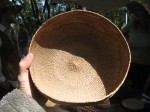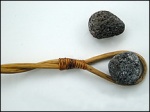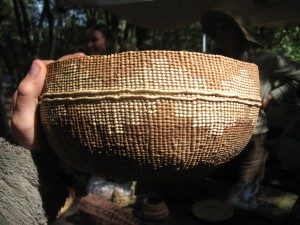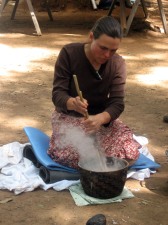Cooking Acorn
Once your acorn is leached, you’re ready to cook. I started out this blog with a list of amazing acorn recipes. You can also just boil up your acorn in a pot for a tasty breakfast or side. I’ll post a basic recipe and those same links below.
 But Native Californians didn’t use pots and pans before Europeans came and destroyed their Native way of life. How do you cook, if your culture doesn’t use pots? Native Californian cultures are famous virtuosos of basketry. One basket can take many months to complete, and is woven with many native plant materials that, themselves, take long hours of work to harvest and process. This basket is as watertight as any pot, woven in a traditional Miwok style.
But Native Californians didn’t use pots and pans before Europeans came and destroyed their Native way of life. How do you cook, if your culture doesn’t use pots? Native Californian cultures are famous virtuosos of basketry. One basket can take many months to complete, and is woven with many native plant materials that, themselves, take long hours of work to harvest and process. This basket is as watertight as any pot, woven in a traditional Miwok style.
Imagine putting such beautiful, subtle artwork on a fire! It would scorch or burn through. So Julia Parker taught us the traditional Miwok way to cook acorn in a basket.
Julia built a “log cabin” fire around about ten fist-sized or bigger vesicular basalt stones. She also had two wooden paddles, about three feet long, and a stirring stick (looped at  the end), all soaking in a bucket of water. We mixed up the acorn meal with water in a big basket and Julia used the long paddles to take the the now red-hot stones from the fire. She dipped each stone carefully into a bucket of clean water to wash off the ash. Then Julia’s daughter Lucy received each stone in the stirring stick, and carefully lowered the stone into the basket of acorn.
the end), all soaking in a bucket of water. We mixed up the acorn meal with water in a big basket and Julia used the long paddles to take the the now red-hot stones from the fire. She dipped each stone carefully into a bucket of clean water to wash off the ash. Then Julia’s daughter Lucy received each stone in the stirring stick, and carefully lowered the stone into the basket of acorn.
The acorn bubbled and hissed as the stone went in. After the second stone, the mixture boiled, and Lucy turned the stones gently with the stirring stick to keep it from burning. When the boil stopped, she took a stone out and added a fresh one from the fire.
Everyone took a turn at cooking with rocks. The acorn became gelatinous, and expanded like oatmeal after only four rocks. Julia said it was done then, but we kept cooking with the rocks so that everyone could get a chance.
Finally, we took out the last of the rocks, and served up the acorn. When they cooled, we could see that the rocks also had a layer of crispy acorn over them, and some people chipped it off and nibbled at it. But we mostly just washed it off. The acorn tasted bland at first, but got sweeter the more I ate. The texture was like cream of wheat, and there was not a trace of bitterness.
If you want to make more modern-style food, here are some additional resources.
Basic stove-top acorn recipe:
Put 1 cup acorn, 2 cups water, and a pinch of salt in a saucepan. Bring to a boil and cook on low, stirring to keep it from sticking to the bottom, until acorn has jelled and thickened to the consistency of cream of wheat. Makes about three servings. As with any new food, only eat a small amount at first, wait a while, and pay attention to what your body tells you before eating more.
Additional recipes:
Another traditional acorn mush recipe
Modern ways to make traditional acorn foods
A very modern approach to acorn, including enchiladas, cheesecake and cookies
The stirring stick photo was taken from:






